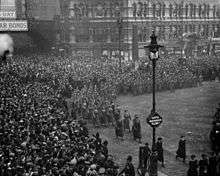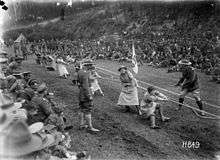Queen Mary's Army Auxiliary Corps


The United Kingdom's Women's Army Auxiliary Corps (February 1917– 27 September 1921), later named the Queen Mary's Army Auxiliary Corps (9 April 1918), was the women's unit of the British Army during and immediately after the First World War.[1]
It was formally instituted on 7 July, 1917 by Sir Neville Macready, the adjutant-general, who had appointed Dr Mona Chalmers Watson the first Chief Controller and senior officer. [2] Over 57,000 women served between January 1917 and November 1918.
On 31 March 1917, women in the WAAC were first sent to the battlefields in France, just 14 cooks and waitresses.[3] Helen Gwynne-Vaughan was the Senior Officer overseas, and Florence Leach was the controller of the cooks. In 1918 women medical personnel were sent to the front in France; one such was Dr. Phoebe Chapple, who was awarded the Military Medal for her actions during an air raid on the WAAC shelter trench outside Abbeville in May 1918.[4]
The corps was disbanded in September 1921. After a German air raid in September 1940 most of the service records did not survive. Those which did have suffered fire, water and mould damage. The National Archives in Kew, Surrey, digitised these to prevent further damage and they can be searched and viewed online. The last WAAC veteran was Ivy Lillian Campany, who died in 2008.
List of Controllers
- Chief Controllers
- Dr Mona Chalmers Watson (February 1917 to 1918)
- Hilda Horniblow (Chief Controller in France in 1917, and in England from July 1918 succeeding Mrs Long.[5]
- Dame Florence Leach (1918 to 1920) (from 1917 Controller-in-Chief)[6]
- Controllers
- Helen Gwynne-Vaughan; Controller, later Commandant of the Women's Royal Air Force
See also
References
- ↑ Pennington, Reina (2003). Amazons to Fighter Pilots - A Biographical Dictionary of Military Women (Volume 2). Westpoint, Connecticut: Greenwood Press. pp. 464–465. ISBN 0-313-29197-7.
- ↑ Spiers, Edward M., ed. (2011). A Military History of Scotland. Edinburgh: Edinburgh University Press. p. 23. ISBN 9780748633357. Retrieved 8 March 2015.
- ↑ Bidwell, Shelford. The Women's Royal Army Corps, p. 1.
- ↑ "Military Medal: Dr Phoebe Chapple, Royal Army Medical Corps". Australian War Memorial. Retrieved 19 May 2016.
- ↑ "Horniblow [married name Dalton], (Emilie) Hilda". Oxford Dictionary of National Biography (online ed.). Oxford University Press. doi:10.1093/ref:odnb/62131. (Subscription or UK public library membership required.)
- ↑ Bidwell, Shelford (1997). The Women s Royal Army Corps. Pen & Sword. p. 28. ISBN 9780850520996. Retrieved 1 April 2018.
External links
| Wikimedia Commons has media related to Queen Mary's Army Auxiliary Corps. |
- Women's (later Queen Mary's) Army Auxiliary Corps (1917–1920) – DocumentsOnline research guide
- DocumentsOnline searchable service record collection
- On Waactive Service by Majorie Hay, an account of the Corp. in France 1917 – 1918, The Plymouth Press, circa 1919